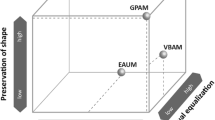Abstract
Variable-scale map because of its variability, destroys the constant of original scale, causing the map enlarge regional information easy to read, other regions are severely compressed and difficult to identify, reducing the map legibility. In this paper, we proposed a new pattern called Voronoi Feature Selection to solve the problem of information compression, considering map’s legibility and equilibrium. The main idea is that we use voronoi adjacency relationship model to select features, instead of traditional euclidean distance model, use voronoi influence ratio to determine the feature whether or not to remain, and remove the small influence features to reduce the loading of extrusion area, as well as improve the legibility of map. The comparative experiment results show that our methods make the transformed map readability and clearness to express, and it has a good feasibility.
Access this chapter
Tax calculation will be finalised at checkout
Purchases are for personal use only
Preview
Unable to display preview. Download preview PDF.
Similar content being viewed by others
References
Wang, Q., Hu, Y.: A CAC-based General Multi-focal Pojection. Joural of Wuhan Technical University of Surveying and Mapping 17, 18–25 (1992) (in Chinese)
Wang, Q., Hu, Y.: A Kind of Adjustable Map Projection With “Magnifying Class” Effect. Agta Geodaetioa et Cartographica Sinica 22, 270–278 (1993) (in Chinese)
Yang, X., Yang, Q., Zhao, Q.: A New Kind of Variable-scale Map Projection Research on Composite Projection. Journal of Wuhan Technical University of Surveying and Mapping 24, 162–165 (1999) (in Chinese)
Harrie, L., Tiina Sarjakoski, L., Lahto, L.: A Variable-Scale Map for Small-Display Cartography. In: Proceeding of the Joint International Symposium on “Geospatial Theory, Processing and Applications,” (ISPRS/Commission IV, SDH 2002), Ottawa, Canada (2002)
Ai, T., Liang, R.: Variable-Scale Visualization in Navigation Electronic Map. Geomatics and Infromation Science of Wuhan University 32, 127–130 (2007) (in Chinese)
Hampe, M., Sester, M., Harrie, L.: Multiple Representation Databases to Support Visualization on Mobile Devices. In: Proceeding of the XXth ISPRS Congress, Istanbul, Turkey (2004)
Chen, J., Zhao, R.: Voronoi-based k-order neighbour relations for spatial analysis. ISPRS Journal of Photogrammetery & Remote Sensing 59, 60–72 (2004)
Fairbairn, D., Taylor, G.: Developing a Variable-Scale Map Projection for Urban Areas. Computers & Geosciences 21, 1053–1064 (1995)
Gold, C.M.: Review.: Spatial Tessellations-Concepts and Application of Voronoi Diagrams. International Journal of Geographical Information Science 8(2), 237–238 (1994)
Okabe, A., Boots, B., Sugihara, K.: Nearest neighborhood operations with generalized Voronoi diagram: a review. International Journal of Geographical Information System 8(1), 43–71 (1994)
Agrawala, M., Stolte, C.: Rendering Effective Route Maps: Improving Usability through Generalization. In: Proceeding of SIGGRAPH 2001, pp. 241–249 (2002)
Guerra, F., Boutoura, C.: An Electronic Lens on Digital Tourist City-Maps. In: Proceedings of the 20th International Cartographic Conference, Beijing, China, p. 1151 (2001)
Snyder, J.P.: Magnifying-Class Azimuthal Map Projection. The American Cartographer 14, 61–68 (1987)
Sukhov, V.I.: Information capacity of a map entropy. Geodesy and Aerophotography X, 212–215 (1967)
Sukhov, V.I.: Application of information theory in generalization of map contents. In: International Yearbook of Cartography, X, pp. 41–47 (1970)
Author information
Authors and Affiliations
Editor information
Editors and Affiliations
Rights and permissions
Copyright information
© 2012 Springer-Verlag Berlin Heidelberg
About this paper
Cite this paper
Wang, H., Li, J., Pu, H., Li, R., He, Y. (2012). Voronoi Feature Selection Model Considering Variable-Scale Map’s Balance and Legibility. In: Wang, F.L., Lei, J., Gong, Z., Luo, X. (eds) Web Information Systems and Mining. WISM 2012. Lecture Notes in Computer Science, vol 7529. Springer, Berlin, Heidelberg. https://doi.org/10.1007/978-3-642-33469-6_5
Download citation
DOI: https://doi.org/10.1007/978-3-642-33469-6_5
Publisher Name: Springer, Berlin, Heidelberg
Print ISBN: 978-3-642-33468-9
Online ISBN: 978-3-642-33469-6
eBook Packages: Computer ScienceComputer Science (R0)




